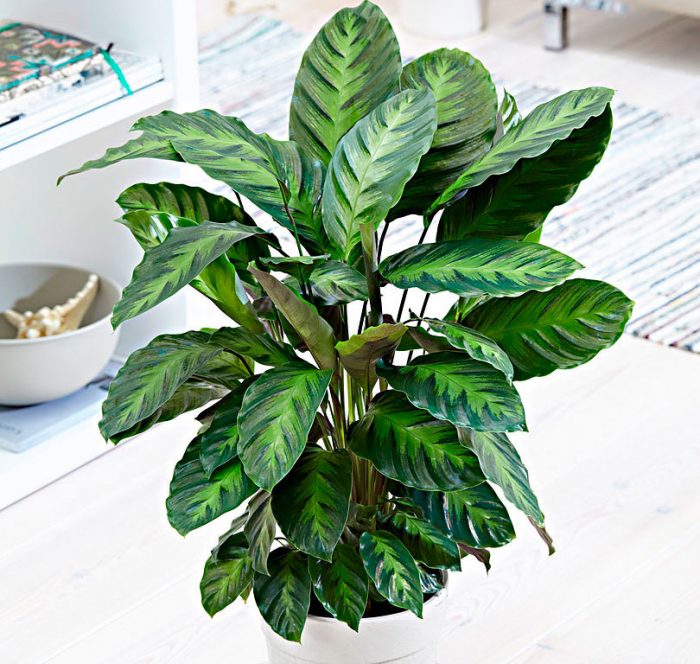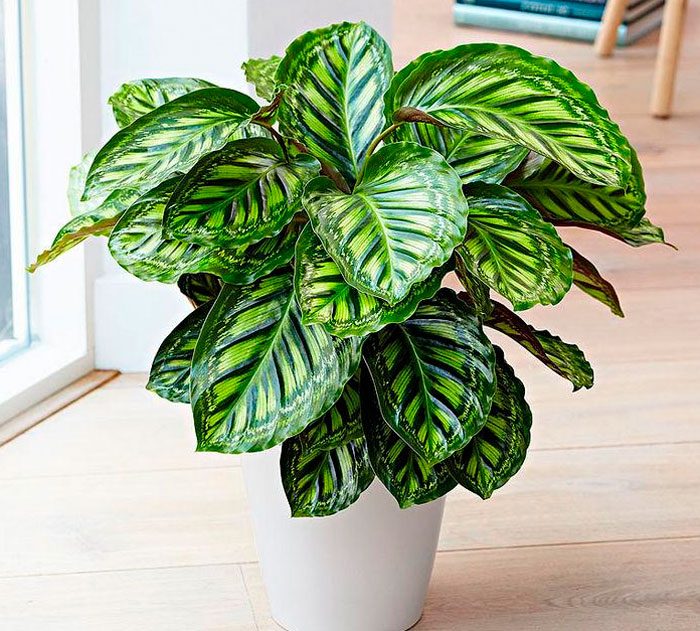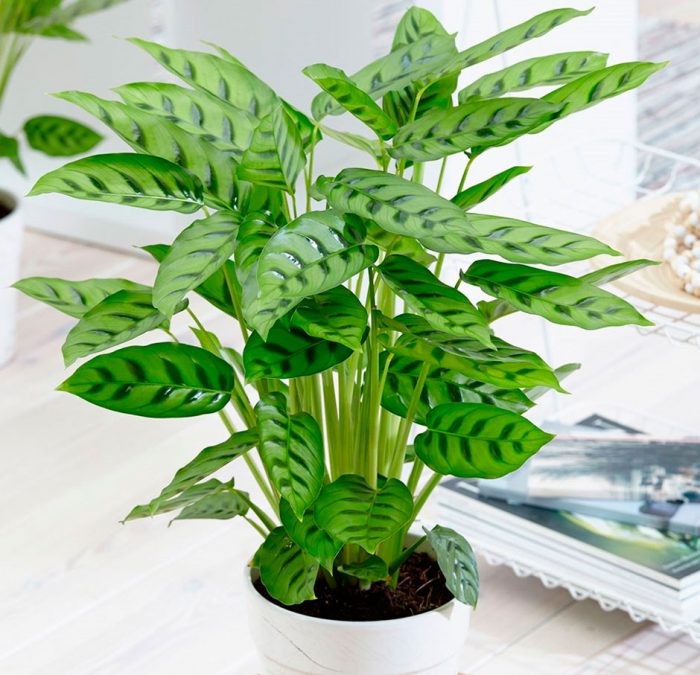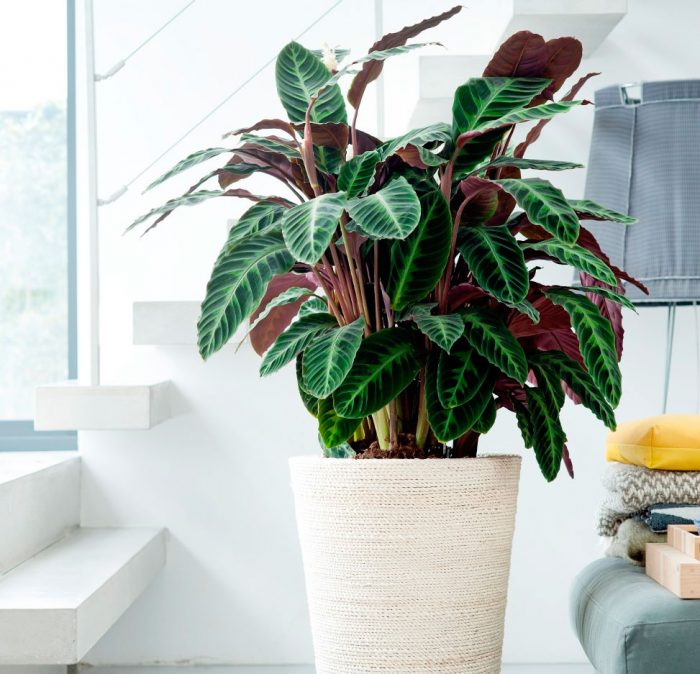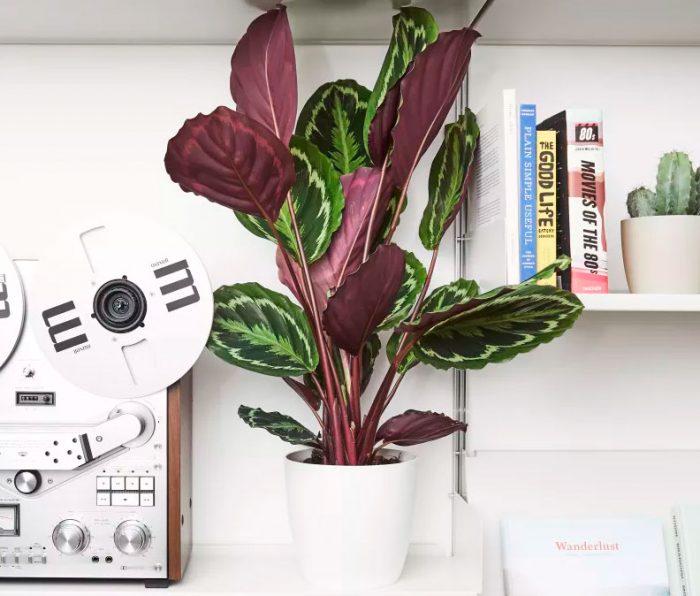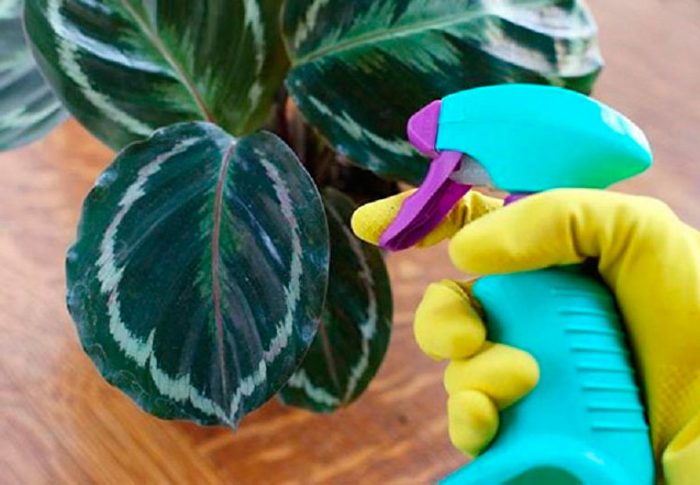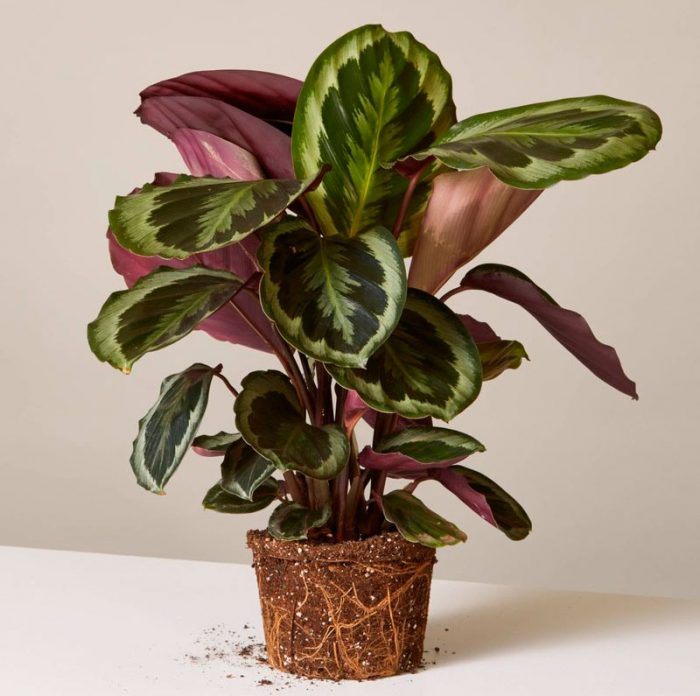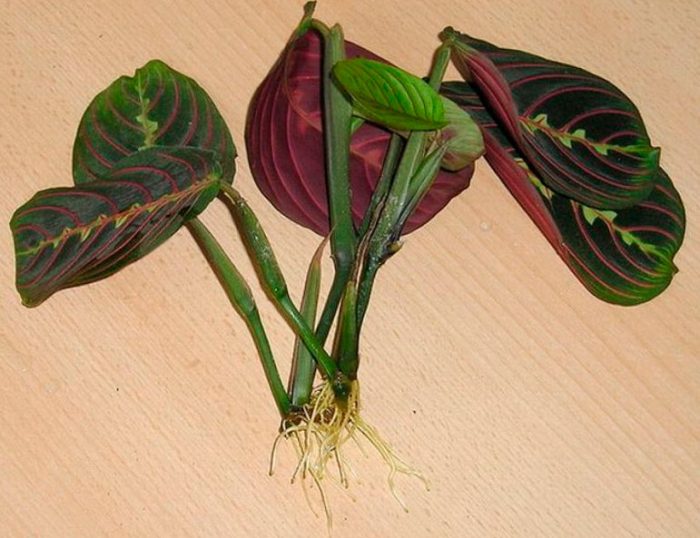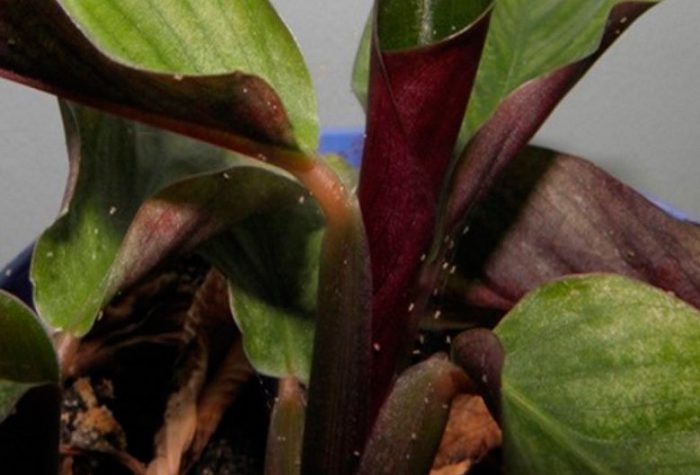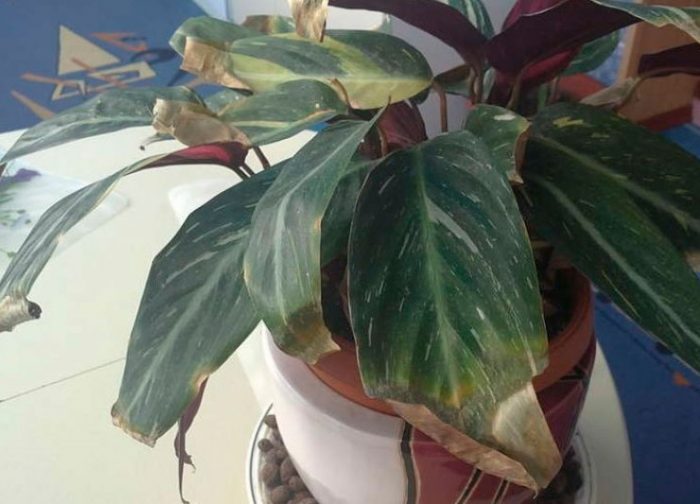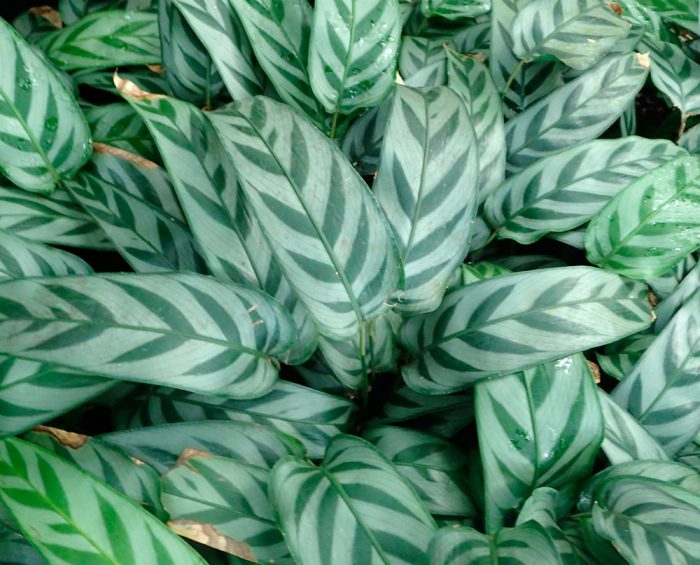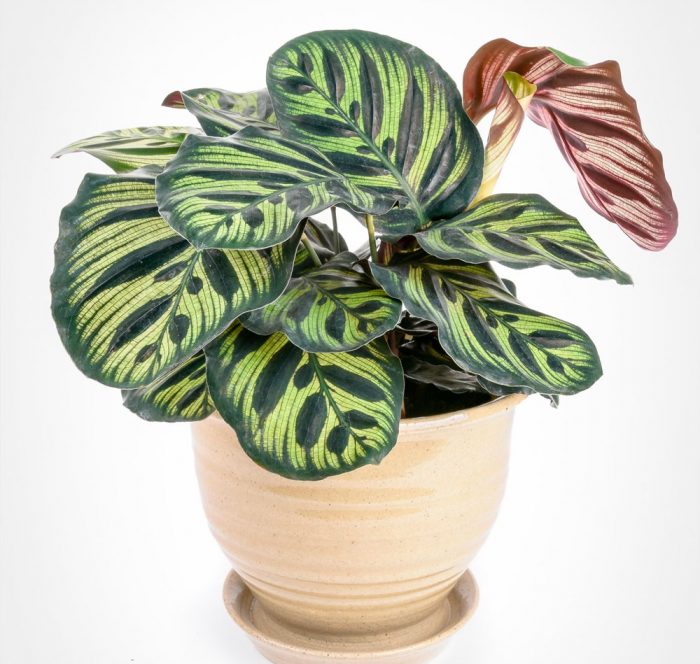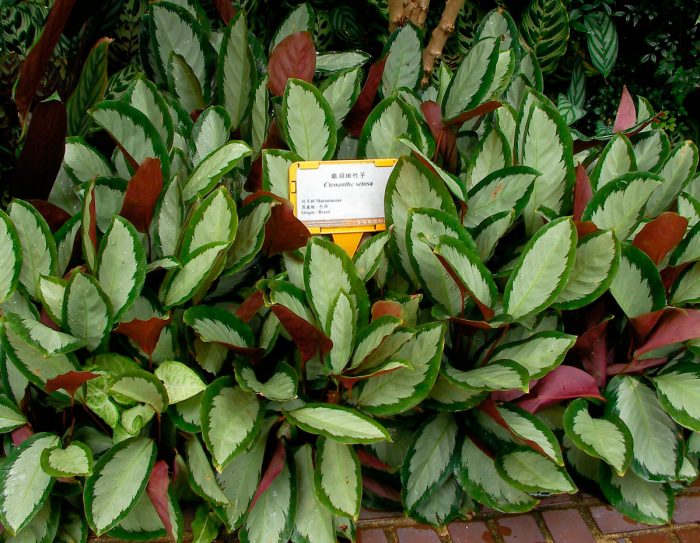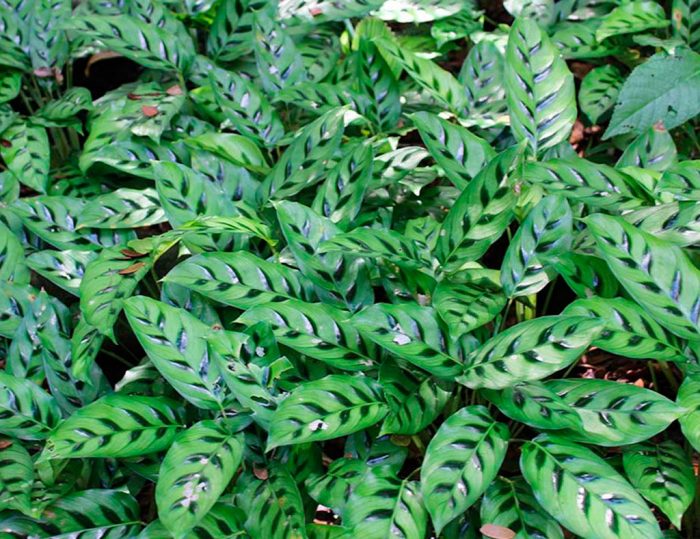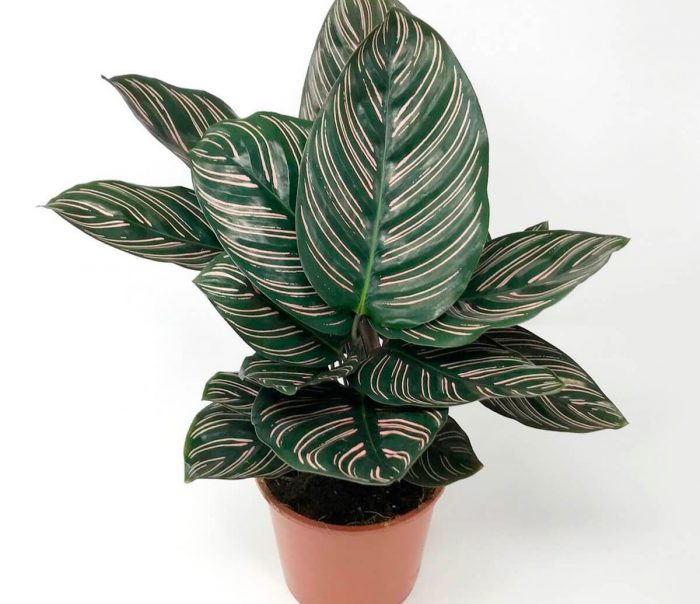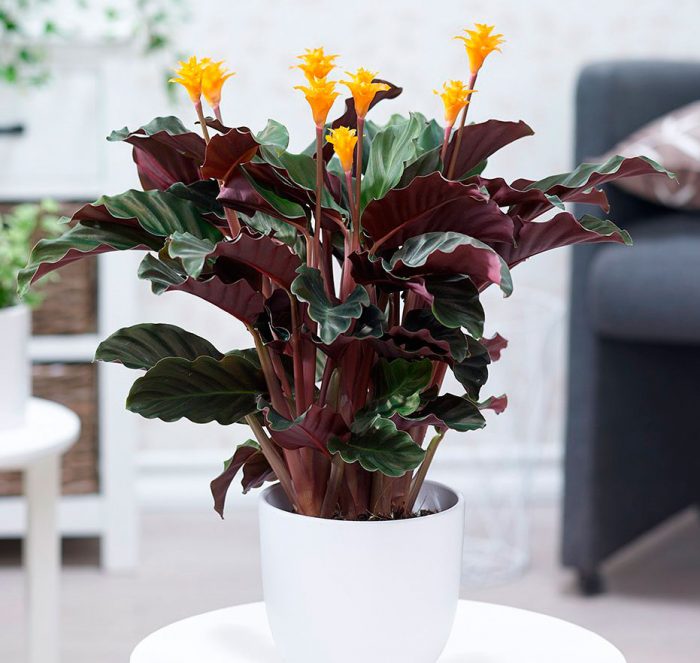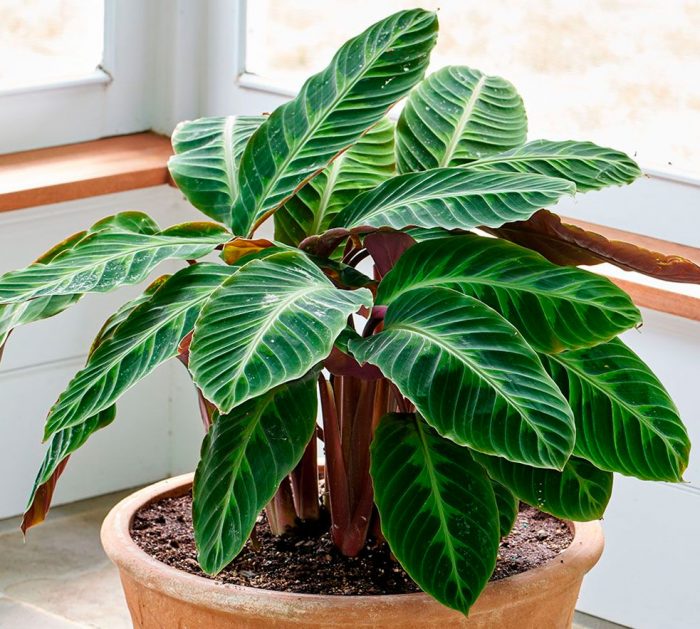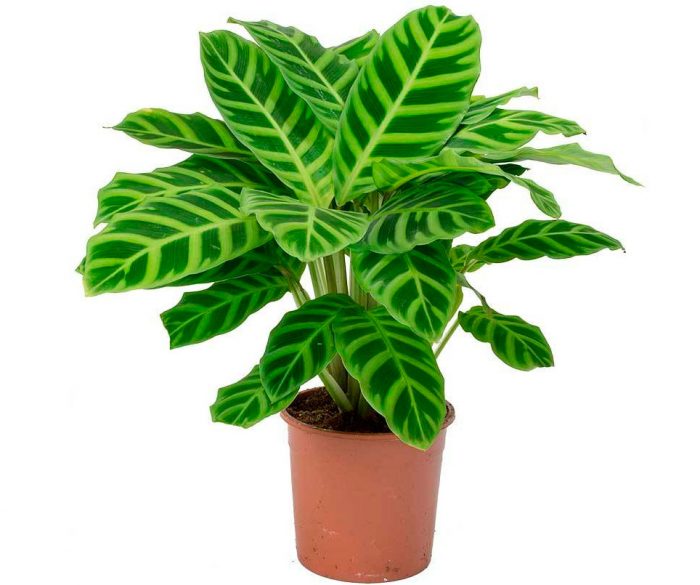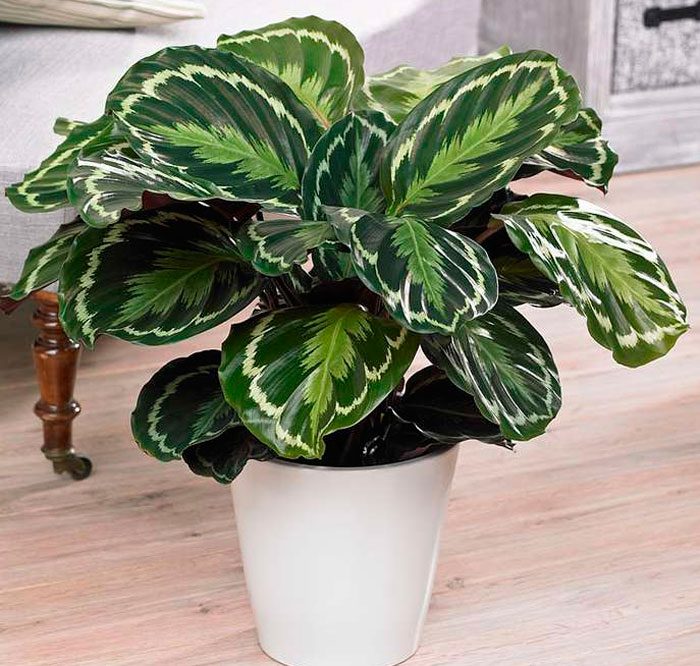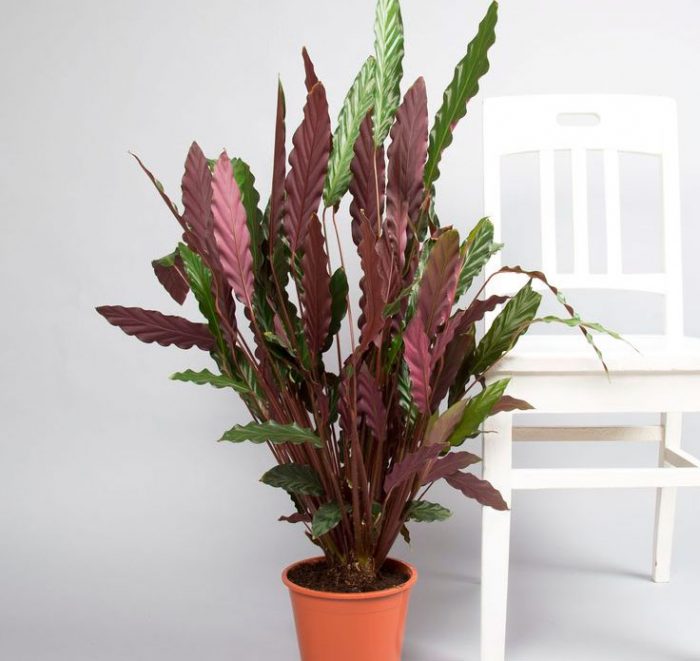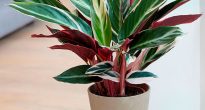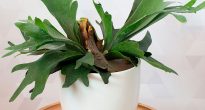The plant Calathea belongs to the Maranth family. This genus is the most numerous of all belonging to this family, and it unites about 130 species. In natural conditions, they can be found in South and Central America. The name of the plant is derived from the ancient Greek word "Kalathos", translated as "basket", this is due to the fact that its foliage was previously used for weaving baskets. However, to date, calathea is mostly grown as an ornamental deciduous plant, because it has a very spectacular foliage of variegated color. She is able to decorate any home, but if you want to grow such a flower, then pay attention to the fact that it is very demanding both in terms of care and growing conditions.
Content
- 1 Brief description of cultivation
- 2 Features of calathea
- 3 Caring for calathea at home
- 4 Reproduction methods
- 5 Diseases and pests
- 6 Types of kalata with photos and names
- 6.1 Calathea bachemiana
- 6.2 Calathea makoyana
- 6.3 Calathea picturata
- 6.4 Calathea leopardina
- 6.5 Decorated calathea (Calathea ornata)
- 6.6 Saffron calathea (Calathea crocata)
- 6.7 Calathea warscewiczii
- 6.8 Calathea striped or zebra-like (Calathea zebrina)
- 6.9 Calathea veitchiana or Veitchiana
- 6.10 Calathea rufibarba
- 7 Signs associated with calathea
Brief description of cultivation
- Bloom... Most species are cultivated as decorative deciduous plants. And the types of saffron calathea and Varshevich calathea bloom in January-February.
- Illumination... Slight shading.
- Temperature regime... It grows well at normal room temperature, but it should not be less than 16 degrees.
- Watering... Water should be abundant throughout the growing season, and moderately in winter.
- Air humidity... Its level should be around 90 percent. To increase the humidity, wet pebbles are poured into the pallet, and a pot with a flower is placed on it, or its foliage is regularly moistened with a spray bottle.
- Fertilizer... The plant is fed once every 2 weeks in April – August; for this, a complex mineral fertilizer is used for decorative leafy plants.
- Dormant period... Not pronounced. It usually starts in September and ends in January.
- Transfer... Young specimens are subjected to this procedure once a year, and older ones - once every 2 or 3 years.
- Reproduction... Cutting, dividing the bush and seed method.
- Harmful insects... Scabbards, thrips and spider mites.
- Diseases... Rhizoctonia. If the flower is improperly looked after, then problems with its foliage may begin.
Features of calathea
Calathea differs from many other plants in its spectacular foliage, but it also has other characteristic features. Most of the calathea species have underground stems that form the superficial root system, it is from this that rosettes grow, consisting of large oval-shaped leaf plates, their length varies from 0.3 to 0.4 m.The leaves have long petioles. The height of the bush can vary from 0.7 to 0.9 m. During flowering, flowers are formed on the plant, which do not represent any decorative value. However, Calathea Varshevich and Calathea saffron bloom quite effectively, their unsightly flowers are hidden behind spectacular bracts, which can be painted white, pink, cream or orange.
When grown in indoor conditions, calathea is distinguished by high demands on conditions of maintenance and care. But there are species and varieties that are less demanding than the rest. So, it is easiest to grow in indoor conditions such species as: Bahema calathea, decorated, Makoya, striped, Veicha (Vicha), etc.
Like the rest of the representatives of the Marantovaya family, the calathea has one peculiarity - in the evening, its foliage folds and rises up, like the palms of a praying person. In the morning, the leaf plates are lowered and straightened again. Calathea, like its related arrowroot, is also called the "prayer flower".
Caring for calathea at home
Illumination
Calathea is a tropical plant and therefore it is distinguished by its light and thermophilicity. However, everything is fine in moderation, for example, if there is a lot of light, then the color of the leaf plates will become brown, and if too little, then they will fade and lose their decorative effect. In this regard, it is necessary to choose a place for the flower that is in a little shade. Make sure that no direct rays of the sun fall on its foliage.
Temperature regime
The temperature in the room where the calathea is located should change very smoothly. Protect her from sudden temperature changes during the day. Cold (air temperature less than 16 degrees) and even the smallest draft can harm her.
Watering
For calathea, it is very important what quality water you use for irrigation. The water temperature should be 2-3 degrees above room temperature. You also need to water the bush with exceptionally soft water, for example, thawed or rainwater. However, if you only have tap water, then fill a bucket with it in the evening and place in it 2 or 3 handfuls of peat, which must first be wrapped in gauze. In the morning, this water can be used to water the calathea.
In spring and summer, the bush should be watered abundantly. After some time after moistening the soil mixture in the pot, be sure to pour the excess water accumulated there from the pan, otherwise the root system may rot. In winter, water the flower sparingly. Experts advise choosing such an irrigation regime for calathea, in which the substrate in the container would be constantly slightly damp (not wet).
Air humidity
For the normal growth and development of domestic calathea, increased air humidity is required. The recommended level of humidity in the room where the flower is located is about 90%. However, it is very difficult to maintain such a level of humidity at home; instead, the foliage of the bush is systematically wiped with a damp soft cloth or moistened with warm water from a spray bottle. However, this method of increasing humidity is only suitable for those species and varieties in which the leaf plates are hard and smooth. Those varieties that have velvety foliage cannot be moistened with a spray bottle or washed with a sponge.In this case, to maintain high air humidity, moistened pebbles are poured into the pan, and a pot with a flower is already placed on it, while making sure that its bottom does not come into contact with the liquid. It is most convenient to grow such a flower in florariums or aquariums, because it is much easier to maintain an increased level of humidity there.
Top dressing
As for feeding calathea, you need to remember a very important rule, fertilizers need to be applied to the soil mixture so much that the plant has enough of all the nutrients. However, you cannot overfeed the flower, as this can cause problems with it.
Top dressing is carried out in April – August, for this, a complex mineral fertilizer for decorative deciduous plants is introduced into the substrate once every 15 days. Calathea Varshevich and saffron should be fed with complex fertilizer for decorative flowering indoor plants.
Calathea transplant
While the bushes are young, they should be transplanted regularly once a year; older plants are subjected to this procedure less often, or rather, once every 2 or 3 years. Calathea should be transplanted in the spring. The pot for planting it is chosen not very large, wide and rather low. A substrate suitable for growing calathea should be slightly acidic, friable and well breathable. It is best to buy a ready-made mortar for rhododendrons or arrowroot in a specialized store. However, if you wish, you can prepare the substrate with your own hands; for this, mix the calcined river sand with peat, humus and deciduous soil (1: 2: 2: 2).
Calathea needs to be transplanted not only very carefully, but also correctly. To begin with, a thick layer of drainage should be laid on the bottom of the pot, which is covered with a layer of fresh earth mixture. After that, transfer the bush into a new pot, while trying not to damage the roots and not destroy the clod of earth. Then carefully fill any voids in the pot with fresh potting soil.
Reproduction methods
Dividing the bush
During the transplantation of calathea, which is carried out in the spring, the rhizome of an adult bush, if desired, can be divided into parts. It should be borne in mind that each of the divisions must have several formed roots and leaf plates. Plant the cuttings in individual pots, up to 70–90 mm in diameter, which are filled with arrowroot substrate. Move them to a shaded area and keep them warm and humid. To do this, it is recommended to put the pots on a pallet filled with wet expanded clay, while a working heating device should be located nearby. It takes a very long time to root the divisions, and the end result depends on how well you take care of them.
Propagation by cuttings
Very carefully cut off the aboveground cutting from the mother bush. For rooting, it is planted in a moistened substrate, after which it is covered with a cut plastic bottle or a transparent bag on top. It will be possible to remove the shelter only when the stalk gives roots. When starting to cuttings, you need to take into account that the cutting may not give roots, and this happens quite often.
Growing from seeds
It is extremely difficult to grow calathea from seeds, since even high-quality seed material may not germinate. Take a bowl and fill it with a substrate consisting of sand and leafy soil (1: 2), after which seeds are sown into it. Crops are harvested in a warm place (from 21 to 25 degrees). After the emerging seedlings have formed the first pair of true leaf plates, they will need to be cut into a box filled with the same substrate that is used for sowing. The grown and strengthened plants are transplanted into separate pots.
Diseases and pests
Pests
In the event that the room where the calathea grows has excessively dry air, then thrips, spider mites and scale insects can settle on it.Whichever of these pests attacks the plant, it will begin to yellow and die of foliage.
How to save a flower affected by harmful insects? The first signs that pests have settled on the bush are a sticky bloom, a thin cobweb or dots of a pale color on the surface of the leaf plates. As soon as one of these signs is detected, action must be taken immediately. To get rid of thrips and scale insects, the foliage is washed with a soap solution. However, if after such treatment the pests remain, then it will be necessary to spray the bush with a solution of a special insecticidal preparation. Spider mites are fought with special chemicals
Possible problems
Improper care and inappropriate growing conditions can cause various problems with the flower:
- Drying foliage tips... If only the tips of the leaf plates dry, then this is due to excessively dry air. In this case, they begin to moisten the bush from the spray bottle more often, while the pot with it is placed on a pallet filled with wet pebbles.
- Dry spots on the leaves... Most often they appear when spraying a bush, when too large drops of water remain on the foliage. When the sun's rays hit these droplets, it causes sunburn.
- Drying foliage... This can happen due to drafts, excessively poor watering, or when thrips settle on the flower.
- Yellow foliage... If only the lower leaf plates of the calathea turn yellow, then there is no need to worry, because this is a completely natural process associated with the death of old leaves. If not only the lower leaves turn yellow, then this may be due to the fact that the bush is overfed with fertilizers or is not watered correctly. Leaves can turn yellow both due to a lack of moisture and due to the fact that liquid regularly stagnates in the root system. It is necessary to moisten the substrate in the pot only when its top layer dries out to a depth of about 20 mm. Otherwise, the roots of the flower will not receive enough oxygen, and rot will appear on them, and the foliage will begin to actively yellow. You should also be careful about feeding Calathea. Please note that a nutrient solution prepared from half the manufacturer's recommended fertilizer dose should be applied to the soil (see package instructions). Yellowing of the foliage may also be due to the fact that the room is too cold.
- Twisting the foliage... Drying and curling of foliage occurs due to excessively low temperature or humidity, and also due to exposure to drafts.
Absolutely all the problems that can arise when growing calathea at home are associated either with violations of the rules of care, or with the failure to provide the plant with suitable conditions for growth. In this regard, in order for your flower to always be healthy and beautiful, you just need to properly care for it and do not forget about the agrotechnical rules of this culture.
Types of kalata with photos and names
Below will be described those types and varieties of calathea that are most popular with flower growers.
Calathea bachemiana
This species, whose homeland is Brazil, is considered the most unpretentious of all. The bush has no stems. The length of the leathery lanceolate leaf plates is about 40 centimeters, they are colored in a silvery-green hue, and they are decorated with a dark green pattern, which is located along the central vein.
Calathea makoyana
The homeland of this species is also Brazil, the bush can reach a height of about half a meter. The length of the wide-oval foliage is up to 20 centimeters, and the width is about 10 centimeters. The front surface of the plate is white, almost transparent; it is decorated with deep green veins and pale red spots, as well as a pattern consisting of dark green stripes.
Calathea picturata
Oblong leaf plates in length reach about 20 centimeters, they have a strip of greenish color along the edge, and the median vein is painted in the same shade. The central part of the plate is dark green.
Calathea leopardina
The height of such a stemless bush can vary from 0.4 to 0.5 m. The shape of the greenish leaf plates is oval-lanceolate, their width is from 3 to 4 centimeters, and their length is from 10 to 12 centimeters. They are decorated with dark green elliptical spots, which are interconnected by a median vein.
Decorated calathea (Calathea ornata)
The native land of the species is the Colombian humid forests. A low-growing bush in height reaches only 15 centimeters. The oval foliage is about 20 centimeters long and about 5 centimeters wide. The front greenish-yellow surface of the leaves is decorated with lines of pink and silver shades, and the seamy surface is purple. The species has such varieties as: Calathea ornata roseolineata and Calathea sanderiana.
Saffron calathea (Calathea crocata)
The front surface of the foliage is dark green, and the back is almost brown. If you provide the species in indoor conditions with a long daylight hours (about 10 hours), then in January-February the bush will bloom. The spectacular inflorescences that appear can be colored orange or deep yellow.
Calathea warscewiczii
The species has a spectacular velvety foliage, which has a greenish pattern on the front surface along the central vein, while its underside is purple. During flowering, very showy white, cream or pink inflorescences form.
Calathea striped or zebra-like (Calathea zebrina)
A plant native to tropical Brazil. The shape of the leaf plates is elliptical, they reach 40 centimeters in length and up to 15 centimeters in width. The seamy surface of the leaves is pale red, and the obverse is dark green, and it is decorated with greenish feathery stripes.
Calathea veitchiana or Veitchiana
The height of the bush is about 0.9 m. The smooth foliage has an oval shape, it reaches about 30 centimeters in length and up to 10 centimeters in width. The dark green upper surface of the plate is decorated with greenish yellow stripes, and the purple lower surface is decorated with yellow stripes.
Calathea rufibarba
The species received this name because on the seamy surface of the monochromatic foliage and on the petioles there is a pubescence of a red color. Elongated leaves have a slightly wavy edge. There are varieties:
- «Blue Grass»- both foliage surfaces are green;
- «Wavestar"- the seamy surface of the foliage has a lilac color.
Florists also cultivate such species as: Calathea Litze, Orbifolia, "Queen of Maui", Lubbers, medallion (roseopicta), wonderful (lanceolate), etc.
Signs associated with calathea
Most people believe that calathea brings comfort and peace to the home, because it is a symbol of family happiness. According to astrologers, this flower is associated with the Sun and Mars, in this regard, it is able to neutralize aggression and tune the owners to a peaceful mood.

